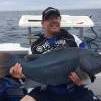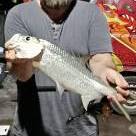
MAH
-
Content Count
193 -
Joined
-
Last visited
-
Days Won
44
Reputation Activity
-
 MAH reacted to Des in WRACK ON not WRACK OFF.
MAH reacted to Des in WRACK ON not WRACK OFF.
Mark, It is always the Food stupid! ... the saying borrowed from political campaigns ! I am sure you will get my drift
So it is all about the best conditions for the baitfish.
Always follow the baitfish.
The falling Tide is best. The baitfish retreat and congregate in weedy areas. Flathead follow and also congregate. I don't get as many on the incoming tide.
Too Windy. Little baitfish need protection and head out deeper or into sheltered deeper channels.
Too Cold. Deeper water is warmer than the chilly shallows for the sensitive baitfish. And this also applies with heat and hot water.
Overcast. Baitfish think they are safer and are more dispersed over the flats. Maybe the birds above don't see them as easily. I have trouble seeing the terrain on overcast conditions as well. No concentrated baitfish makes harder fishing.
Sunny. Bait fish head deeper and into the weeds for cover. Birds pick them off too easily in clear sunny conditions. This helps as it concentrates your fishing areas. I have had an overcast slow day turn on it's head as soon as the sun came out and stayed out.
So let us configure the idyllic day
There isn't one I have combed through my fishing logs to find the magic combo and there ain't one. They are on excel spreadsheets and i check results by various logged factors in ascending and descending order .... anal analysis
The single most important factor is the presence of baitfish in the shallows. Then follow them depending on the conditions on the day.
In regards to the presence of baitfish ... NOW is the best. The ambient water temperatures is a primary reason. The food source created by the composting Weed Wracks increases the presence of baitfish. Spring ain't too bad either. Ambient water temperatures but not as much food for the baitfish.
Go out and get them! Good luck!
Cheers, Des
PS. Tell Tackle World to send me my commission
-
 MAH got a reaction from Des in WRACK ON not WRACK OFF.
MAH got a reaction from Des in WRACK ON not WRACK OFF.
Great post. After reading this I need to get myself sorted for some flathead fishing on the flats.
What conditions are you looking for? Is it like YFW with the tides, aiming for when they are concentrated at the bottom of the tide? What surface conditions are you looking for?
I'm off to Tackle World on Thursday night to fit out my lures with new assist hooks and then hit the flats.
Cheers
Mark
-
 MAH reacted to Des in WRACK ON not WRACK OFF.
MAH reacted to Des in WRACK ON not WRACK OFF.
For the Yellow Fin Whiting Lure fanatics it is time for the withdrawal symptoms to start setting in, as the water temperatures start dropping.
Fortunately there is some pain relief, in chasing a few Flathead on lures.
Autumn brings a transition for the sandflats lure fisherman. YFW surface lure fishing drops off. Flathead lure fishing picks up. The “Southern Blue Spotted Flathead” becomes more prolific on the sandflats of the Northern SA Gulfs.
.
And it is the large accumulation of SEAGRASS WRACKS at this time of the year, along with the change in temperature, that starts it all off. Unlike the claims of some armchair academic experts, the sandflats areas where large Seagrass Wracks accumulate, is where you will find the greatest concentration of Flathead at this time of the year.
.
SEASONAL CHANGES IN THE ECOSYSTEM
It is a season of change. And multiple factors come into play.
The most fundamental change is in water temperature. Daily air temperatures have a tighter range, fortunately without those cold mornings of winter. Water temperature, currently around 18c provides the ambient conditions for baitfish. The sandflat shallows hold a lot more baitfish in these temperatures. And they linger all day in the shallows. And where baitfish linger so to do Flathead.
Also and most importantly, large Seagrass Wracks form at this time of the year.
The annual shedding of seagrass leaves through Autumn and Winter along with the higher tides and prevailing breezes, causes the accumulation of seaweed wracks in the northern SA gulfs, over these cooler months.
In the ambient autumn temperature conditions the Wracks host an explosion of life in this ecosystem.
When the organic material decomposes and breaks down it contributes to the food web systems by supplying essential nutrients. The composting seagrass accumulations are the source of detritus and of particulate and dissolved nutrients which contribute to beach and inshore marine foodwebs. Starting from (micro) zooplanktons, amphipods, bivalves, worms, crabs, juvenile prawns, clickers and … lots and lots of small baitfish. Seaweed Wracks are at the start of the food chain that delivers us the fish we catch.
~ Weed Wracks, the start of the food chain, so thick that getting onto the sandflats can be difficult
There are many other signs that the bait fish are around in greater numbers.
Their predators gather, both from above the water and under the water.
When the Bird watching groups start reporting some big numbers of bait fish eating bird varieties, you know the water borne bait fish feeders (Flathead) will also be about.
~ An abundance of Baitfish feeding Birds. A sure sign of Flathead around.
With all the indicators pointing to an abundance of Flathead, I decided to spend a couple days immersed in the northern St Vincent Gulf sandflats environment.
~ Catching fish is a bonus in this delightful environment
The best terrain is the weedy areas. The baitfish hold and shelter there and so do the Flathead chasing them.
Weed barren sand patches hold very few Flathead. However a few whiting are likely while traversing a Flathead barren sand patch.
.
LURE SELECTION & TECHNIQUES
I Don’t subscribe to a long held approach for lure fishing Flathead.
I don’t fish the bottom. I don’t bounce a lure across the bottom of the sand, puffing the sand.
Flathead have eyes on the top of their heads. Above their head is their main field of vision. The area that they will be concentrating on. Not so much the peripheral vision areas out in front of them on the sand.
So position your lure on top of their heads … Simple!
For this my methods include fishing Soft Plastics under a float. These days, I am mainly using floating or suspending hardbody lures. All with retro fitted assists and single hooks to avoid fouling on and cleanly pulling through the weed adjacent to the Weed Wrack areas.
~ The successful lures on this outing. OSP Bent Minnows and Rapala Shadow Raps ~
~ Another victim of the OSP Bent Minnow 106mm - Colour: H09. Crystal Blue Shiner
~ One on the Rapala Shadow Rap 07 - 70mm Colour: Moss Back Shiner. It pays to cast over the same area with 2 size lure offerings. Sometimes they are not in the mood for a big feed.
~ Assist hooks at work. Flathead can be clumsy strikers of a lure due to a blind spot created from the setting of their eyes. Apart from pulling through weed easily, assist hooks also increase your hook up rate.
This concept of fishing lures above the flathead’s eyes rather than in front of it, has in recent times gained a lot of acceptance with the enormous popularity and success of the floating glide baits now available. They hold and dance above the Flathead’s eyes.
Also bear in mind you are wading and fishing shallow water. Between knee to waist deep. So there is no need for any deep diving lures.
Currently my favourite lures are the OSP Bent Minnow and the Rapala Shadow Rap which were both successfully used on this outing
Your lure retrieval style is critical to your success rate with catching Flathead.
They do not behave like Salmon or Snook. Flathead are not morphologically evolved for chasing down bait fish like Snook or Salmon are. They lie in wait as an ambush predator with a explosive burst of speed. Often slowly stalking, following the baitfish. Then with an explosive burst lunge and seize the baitfish. Especially when the baitfish momentarily pauses.
There is plenty of drone video footage here at JC's Fishing Shenanigans of Flathead stalking baitfish … : https://www.facebook.com/JCsFishingShenanigans
As we most commonly chase Salmon & Snook with lures we have become accustomed to a fast retrieval rate. And the YFW surface lure fishers only know to retrieve fast and continuous!
The lure retrieval rate for Flathead is very slow … Extremely slow! A few erratic twitches now and then followed by a few seconds of dead pause. Should a Flathead strike and you miss the hook up. Pause again and it will most like pounce back on your lure. The stalking or hidden Flathead likes to strike when the baitfish pauses.
~ In knee deep shallow water they go hard. You need to play them out before gliding them into the net.
My arthritic wrists are certainly enjoying the change in retrieval tempo !
RESULTS
Over the two days of pleasant weather I covered a lot of ground, wading the sandflats, searching for and hunting down these beasts. This style of fishing does take some physical effort, but it is the most satisfying experience to successfully find your prey.
I kept 14 fish ranging from 45cm to 69cm. I even picked up a few whiting while traversing a Flathead barren, weed free sand patch.
~ My catch retained for the 2 day outing. I even managed a few whiting while traversing a Flathead barren sand patch.
~ these Flathead are high 60s. Size enhanced by photos taken from the “Anglers Angle” !! T
I also caught and released a couple of 70+cm Flathead.
~ 75cm Blue Spot Flathead … Released
~ Taken close to the weed wracks. A 72cm Flathead … released.
So WRACK ON !!! It’s time to fish the weedy Sandflats.
Cheers and tight lines Des
-
 MAH got a reaction from Des in Braid on my 2500 size reel
MAH got a reaction from Des in Braid on my 2500 size reel
Have a look on Aliexpress for one sold by PLUSINNO Fishing. There are plenty of others but this one looks OK.
-
 MAH got a reaction from HB tragic in Braid on my 2500 size reel
MAH got a reaction from HB tragic in Braid on my 2500 size reel
You can buy gadgets like this from Aliexpress for under $50.
Fill reel/spool with braid, then add required backing line to get perfect depth of line on your reel Reverse the process winding the line back onto the plastic spool (the backing line will be on the bottom) Use a second plastic spool to wind the line onto (the backing line will now be on top) Place this second spool onto the gadegt Wind onto the reel/spool Worth it when you have multiple reels.
-
 MAH got a reaction from gregtech in Braid on my 2500 size reel
MAH got a reaction from gregtech in Braid on my 2500 size reel
What Wert said.
It's not hard and is a useful skill. After a couple of seasons, you can reverse the line again to so you get "new" braid on your reel. If you have a few reels (I currently have 6) it's worth learning. There are loads of videos showing ways to make it an easy process.
-
 MAH got a reaction from Des in Braid on my 2500 size reel
MAH got a reaction from Des in Braid on my 2500 size reel
You can buy gadgets like this from Aliexpress for under $50.
Fill reel/spool with braid, then add required backing line to get perfect depth of line on your reel Reverse the process winding the line back onto the plastic spool (the backing line will be on the bottom) Use a second plastic spool to wind the line onto (the backing line will now be on top) Place this second spool onto the gadegt Wind onto the reel/spool Worth it when you have multiple reels.
-
 MAH got a reaction from Wert in Braid on my 2500 size reel
MAH got a reaction from Wert in Braid on my 2500 size reel
You can buy gadgets like this from Aliexpress for under $50.
Fill reel/spool with braid, then add required backing line to get perfect depth of line on your reel Reverse the process winding the line back onto the plastic spool (the backing line will be on the bottom) Use a second plastic spool to wind the line onto (the backing line will now be on top) Place this second spool onto the gadegt Wind onto the reel/spool Worth it when you have multiple reels.
-
 MAH got a reaction from Wert in Braid on my 2500 size reel
MAH got a reaction from Wert in Braid on my 2500 size reel
What Wert said.
It's not hard and is a useful skill. After a couple of seasons, you can reverse the line again to so you get "new" braid on your reel. If you have a few reels (I currently have 6) it's worth learning. There are loads of videos showing ways to make it an easy process.
-
 MAH reacted to Des in CHAIN REACTIONS with CHANGING SEASONS
MAH reacted to Des in CHAIN REACTIONS with CHANGING SEASONS
The seasons are changing. The temperature is rising.
The water is warming. It is all happening a bit earlier this year.
Lizards are crawling on the roads. And “Lizards” (flathead) are crawling in the sea.
Water birds are gathering, lining up for a feast of baitfish from above.
The Flathead are lining up for a feast of baitfish from below.
In these ambient temperatures, food is plentiful in the shallows.
The ecosystem has had a great kickstart with the rise in temperatures and every thing comes alive and thrives on the sandflats.
Temperature is the biggest driver for a series of chain reactions, in the sandflats ecosystem.
I am forever monitoring the water temperatures.
The rise in water temperature is early this year.
A series of natural events occur, which results in delivering us fishers, some fine Yellow Fin Whiting and Flathead.
Stimulated by the rise in water temperature about now our local Prawns, the Western King Prawn, start spawning in their mid gulf grounds.
Also now, the Haswell Shore Crabs shrug off their cold weather torpor and also spawn in the inshore shallows.
Post larval Juvenile Prawns start migrating from mid gulf to the warmer, shallow, inshore waters of the upper gulfs.
The Haswell Shore Crab larval zoea, now abundant, provides food for the juvenile Prawns and schools of baitfish.
There is a boom in the population of Juvenile Prawns, Haswell Shore Crabs, and Baitfish in the inshore waters … And also their predators. YFW and Flathead, have moved in, enjoying this abundance of food.
Having experienced a sustained period of exposure to higher water temperatures, the YFW have now, increased their metabolisms and have developed voracious appetites. The larger predatory YFW that I like to target are now aggressively hunting on the sandflats. Devouring juvenile prawns and shore crabs.
So it is a perfect time to place myself at the end of these chain reactions and target some YFW and Flathead.
I took advantage of the warm weekend.
Given the tides, I selected an area that amplifies the small tide movement and works best on the slower tides.
I started with chasing Flathead on the falling tide. The Flathead are very active chasing the baitfish as they retreat to the shelter of weedy areas in deeper water.
Fishing for them in heavily weeded areas does present it’s challenges.
Lures with trebles catch too much weed. And when a Flathead is hooked they will head into the weed. All the exposed treble barbs, hook onto the surrounding weed and help the Flathead throw the lure.
I have recently started to use floating hardbodies like OSP Bent Minnows, with singles and assist hooks, for these areas. These hooks pull through the weed easily. So far, I have yet to have a Flathead throw these hooks.
Look for where the Herons are feeding to show you where the baitfish are and the Flathead will be holding just downstream.
I was able to extract 3 Solid Flathead that were hiding around the weed, terrorising the baitfish, before the tide slowed.
Next on the agenda were the YFW. A good depth of water was holding over the softer feeding sandflat areas. Usually you will find this substrate holds more food and fish.
Whilst not feeding as aggressively as when there is more water movement, the YFW were still keen enough to take a well worked lure offering over the sandflats. My usual favourites, Sugapen, Ecogear ZX and Zipbaits Skinny Pop, were the more successful lures.
However it is a new season and there are always a few new offerings to try out.
They did not get too much time in the water but both these new lures took fish.
The New Sugapen Splash, which is perhaps better suited to a choppier day still took a fish.
Daiwa’s Slippery Dog 80cm in the colour “Ebi” that I had not previously come across, I thought could work well in this area, had some success.
A drop in air pressure with a change in wind direction from North to SW, pushed water up into the gulf and provided a small wind tide. The water movement, stimulated the fish to bite late into the afternoon. “Bob the bag snatcher” is also making an early season appearance. I normally don’t see them on the sandflats till November.
I kept 14 of the better YFW. Most are over 35cm. And the best a very nice 42cm.
The Flats are Firing early this year !!! Hopefully we can look forward to a great season ahead.
The only downside is the heavy toll the professionals have taken over this winter as they increasingly search for alternative species to supplement their restricted and dwindling catches.
Tight lines all.
Cheers, Des
-
 MAH got a reaction from Des in Rui squid jigs
MAH got a reaction from Des in Rui squid jigs
I have a squid jig addiction and currently have jigs by Yamashita, Daiwa, Shimano, Duel (YoZuri) and Rui. I like the Rui jigs quite a bit. Overall the jigs are not quite the same quality as the Daiwa, but they would be close to the others. What sets the Rui jigs apart is the wide range of colours and size and how readily available they are at a good price.
In the Rui jigs I really like the red head and this is the only brand of red head I buy (I use it a lot so have to replace it a couple of time each year due to snags). I've also had a lot of success with the mullet and one that looks a bit like a tiger prawn called KR54 UV Glow. In the past I would buy the Yamashita mullet looking jig, but no longer bother and just buy the Rui. I don't think I will buy Yamashita again.
The one down side to Rui jigs, is the limited range of rattle jigs.
I've always had quick deliveries from Rui. I prefer to order direct from his website rather than through EvilBay.
If I could no longer cheaply buy Daiwa etc from overseas, I'd be perfectly happy to buy just Rui jigs.
-
 MAH got a reaction from Des in Best 3 Jigs
MAH got a reaction from Des in Best 3 Jigs
Duel
Not the easiest to find. Sportfishing Scene at Cavan have the best local stock. Looks like they have the top green jig in stock but a 3.5 only (nothing wrong with this size jig, it sinks very slightly faster). Their online store says they have one left in stock for $24.99.
https://sportfishingscene.com.au/collections/lures/products/duel-ez-q-cast-plus?variant=43779590586610
-
 MAH got a reaction from Des in Best 3 Jigs
MAH got a reaction from Des in Best 3 Jigs
If you are an Amazon Prime member with free international delivery you can find the Duel jigs. They come from Japan, will take a couple of weeks and cost around $25 each.
-
 MAH got a reaction from Wert in Best 3 Jigs
MAH got a reaction from Wert in Best 3 Jigs
If you are an Amazon Prime member with free international delivery you can find the Duel jigs. They come from Japan, will take a couple of weeks and cost around $25 each.
-
 MAH got a reaction from Des in Best 3 Jigs
MAH got a reaction from Des in Best 3 Jigs
Des, you could go with the advice from Wert and Kelvin, but maybe grab a green jig in a prawn pattern?
-
 MAH got a reaction from Wert in Best 3 Jigs
MAH got a reaction from Wert in Best 3 Jigs
Des, you could go with the advice from Wert and Kelvin, but maybe grab a green jig in a prawn pattern?
-
 MAH got a reaction from Wert in Best 3 Jigs
MAH got a reaction from Wert in Best 3 Jigs
Hi Des
I think this was the post
I've changed a couple of things. I now use an Atomic Arrowz squid rod. It has a much shorter butt than most squid rods and I like how it feels in my hand for casting. I've also dropped down in diameter for my braid, so the line has less drag. I still think for a land based fisho lures are one of the least important parts. Being able to cast a good distance to weedy beds has been more important for me. When in my Yak, I use a really cheap 6 foot rod and an old Shimano Sienna reel, as there is no need to cast far, so jigs move up in terms of importance. When in my yak I catch probably 50% on a handline with the jig bobbing up and down under a float.
-
 MAH got a reaction from Wert in Best 3 Jigs
MAH got a reaction from Wert in Best 3 Jigs
Simplest approach would be to grab 3 red-heads, any brand, in size 3.0, as they just catch lots of squid.
But if you want to try a few others, here are my recommendations.
Size
I find 3.0 size jigs the most versatile. They have enough weight to cast well and have a good sink rate for most conditions. If the current is really ripping and you need a heavier jig, you can add a small 2gm sinker, either one specifically made to attach to squid jigs or just a ball sinker to the line. If you find yourself in a shallow area and keep getting snagged, you can put the jig under a float. You can still get the jig to jerk up under the float, but it stops it from going too low and getting snagged.
Colours
First pick would be a red-head and even better if its also phosphorescent so it glows at night. Rui is a good choice for this type of jig.
Second pick would be a natural colour like a silver or bluey silver. Rui make a couple of good ones a mullet and a pilchard.
Yamashita also make some good natural colour jigs in the Yamashita Sutte R range.
Third pick is something with a prawn like pattern. I've had a lot of success with a Rui jig with a white body and orange prawn stripes (it also glows in the dark)
I've also had a lot of success with prawn pattern jigs from Duel
Another good jig has been by Yozuri (owned by the same company as Duel)
Brands
When squid are schooled up, any jig will work. But when you need to put in more effort, the better quality jigs do make a difference in terms of how they sink, dart through the water and sit on the bottom if you let them fall all the way (you want them to sit at 45 degrees with the barbs up to reduce the chance of snags and to increase the hook up if a squid snatches off the bottom).
Rui is a brand that can be bought from many tackle stores and they have an online store. Excellent balance between quality and price. Yamashita can also be found in many stores and online, the Sutte R range is probably on par with Rui for quality.
Duel and many Yo-Zuri jigs are not as readily available in store, but can be found easily online. There are excellent quality jigs and often have added features like silicone legs that waft and create extra movement or they rattle when jerked. These extra features are not absolutely needed, but can help when the squid are not fired up.
-
 MAH got a reaction from Des in Best 3 Jigs
MAH got a reaction from Des in Best 3 Jigs
Hi Des
I think this was the post
I've changed a couple of things. I now use an Atomic Arrowz squid rod. It has a much shorter butt than most squid rods and I like how it feels in my hand for casting. I've also dropped down in diameter for my braid, so the line has less drag. I still think for a land based fisho lures are one of the least important parts. Being able to cast a good distance to weedy beds has been more important for me. When in my Yak, I use a really cheap 6 foot rod and an old Shimano Sienna reel, as there is no need to cast far, so jigs move up in terms of importance. When in my yak I catch probably 50% on a handline with the jig bobbing up and down under a float.
-
 MAH got a reaction from Des in Best 3 Jigs
MAH got a reaction from Des in Best 3 Jigs
Simplest approach would be to grab 3 red-heads, any brand, in size 3.0, as they just catch lots of squid.
But if you want to try a few others, here are my recommendations.
Size
I find 3.0 size jigs the most versatile. They have enough weight to cast well and have a good sink rate for most conditions. If the current is really ripping and you need a heavier jig, you can add a small 2gm sinker, either one specifically made to attach to squid jigs or just a ball sinker to the line. If you find yourself in a shallow area and keep getting snagged, you can put the jig under a float. You can still get the jig to jerk up under the float, but it stops it from going too low and getting snagged.
Colours
First pick would be a red-head and even better if its also phosphorescent so it glows at night. Rui is a good choice for this type of jig.
Second pick would be a natural colour like a silver or bluey silver. Rui make a couple of good ones a mullet and a pilchard.
Yamashita also make some good natural colour jigs in the Yamashita Sutte R range.
Third pick is something with a prawn like pattern. I've had a lot of success with a Rui jig with a white body and orange prawn stripes (it also glows in the dark)
I've also had a lot of success with prawn pattern jigs from Duel
Another good jig has been by Yozuri (owned by the same company as Duel)
Brands
When squid are schooled up, any jig will work. But when you need to put in more effort, the better quality jigs do make a difference in terms of how they sink, dart through the water and sit on the bottom if you let them fall all the way (you want them to sit at 45 degrees with the barbs up to reduce the chance of snags and to increase the hook up if a squid snatches off the bottom).
Rui is a brand that can be bought from many tackle stores and they have an online store. Excellent balance between quality and price. Yamashita can also be found in many stores and online, the Sutte R range is probably on par with Rui for quality.
Duel and many Yo-Zuri jigs are not as readily available in store, but can be found easily online. There are excellent quality jigs and often have added features like silicone legs that waft and create extra movement or they rattle when jerked. These extra features are not absolutely needed, but can help when the squid are not fired up.
-
 MAH got a reaction from yellow door 1 in Best 3 Jigs
MAH got a reaction from yellow door 1 in Best 3 Jigs
Simplest approach would be to grab 3 red-heads, any brand, in size 3.0, as they just catch lots of squid.
But if you want to try a few others, here are my recommendations.
Size
I find 3.0 size jigs the most versatile. They have enough weight to cast well and have a good sink rate for most conditions. If the current is really ripping and you need a heavier jig, you can add a small 2gm sinker, either one specifically made to attach to squid jigs or just a ball sinker to the line. If you find yourself in a shallow area and keep getting snagged, you can put the jig under a float. You can still get the jig to jerk up under the float, but it stops it from going too low and getting snagged.
Colours
First pick would be a red-head and even better if its also phosphorescent so it glows at night. Rui is a good choice for this type of jig.
Second pick would be a natural colour like a silver or bluey silver. Rui make a couple of good ones a mullet and a pilchard.
Yamashita also make some good natural colour jigs in the Yamashita Sutte R range.
Third pick is something with a prawn like pattern. I've had a lot of success with a Rui jig with a white body and orange prawn stripes (it also glows in the dark)
I've also had a lot of success with prawn pattern jigs from Duel
Another good jig has been by Yozuri (owned by the same company as Duel)
Brands
When squid are schooled up, any jig will work. But when you need to put in more effort, the better quality jigs do make a difference in terms of how they sink, dart through the water and sit on the bottom if you let them fall all the way (you want them to sit at 45 degrees with the barbs up to reduce the chance of snags and to increase the hook up if a squid snatches off the bottom).
Rui is a brand that can be bought from many tackle stores and they have an online store. Excellent balance between quality and price. Yamashita can also be found in many stores and online, the Sutte R range is probably on par with Rui for quality.
Duel and many Yo-Zuri jigs are not as readily available in store, but can be found easily online. There are excellent quality jigs and often have added features like silicone legs that waft and create extra movement or they rattle when jerked. These extra features are not absolutely needed, but can help when the squid are not fired up.
-
 MAH got a reaction from yellow door 1 in Creature Bait - Daiwa Bait Junkie vs Lure Supreme Paradise (LSP)
MAH got a reaction from yellow door 1 in Creature Bait - Daiwa Bait Junkie vs Lure Supreme Paradise (LSP)
I'm a big fan of Daiwa Bait Junkie soft plastics and prefer them to Zman. They are very soft and flexible which seems to give them a great action in the water. I recently bought some Daiwa Bait Junkie Risky Critters for when the weather and water warms up. I'm going to give them a try on whatever is swimming around the flats, keen to see if YFW will hit them. Only problem with these soft plastics is the price at $11.95 for a pack of 6. Not a huge cost, but I did stumble across a similar styled creature bait on Aliexpress, pack of 8 for $6.23. They are made from the super stretch material and come in a range of colours. The brand is LSP or Lure Supreme Paradise.
I haven't fished either lure yet, but thought I would throw up a few side by side shots. The Bait Junkie looks like it will waft and flutter about a bit more, but no idea how this translate to bites.
-
 MAH got a reaction from Softy in Creature Bait - Daiwa Bait Junkie vs Lure Supreme Paradise (LSP)
MAH got a reaction from Softy in Creature Bait - Daiwa Bait Junkie vs Lure Supreme Paradise (LSP)
I'm a big fan of Daiwa Bait Junkie soft plastics and prefer them to Zman. They are very soft and flexible which seems to give them a great action in the water. I recently bought some Daiwa Bait Junkie Risky Critters for when the weather and water warms up. I'm going to give them a try on whatever is swimming around the flats, keen to see if YFW will hit them. Only problem with these soft plastics is the price at $11.95 for a pack of 6. Not a huge cost, but I did stumble across a similar styled creature bait on Aliexpress, pack of 8 for $6.23. They are made from the super stretch material and come in a range of colours. The brand is LSP or Lure Supreme Paradise.
I haven't fished either lure yet, but thought I would throw up a few side by side shots. The Bait Junkie looks like it will waft and flutter about a bit more, but no idea how this translate to bites.
-
 MAH got a reaction from Des in Creature Bait - Daiwa Bait Junkie vs Lure Supreme Paradise (LSP)
MAH got a reaction from Des in Creature Bait - Daiwa Bait Junkie vs Lure Supreme Paradise (LSP)
I'm a big fan of Daiwa Bait Junkie soft plastics and prefer them to Zman. They are very soft and flexible which seems to give them a great action in the water. I recently bought some Daiwa Bait Junkie Risky Critters for when the weather and water warms up. I'm going to give them a try on whatever is swimming around the flats, keen to see if YFW will hit them. Only problem with these soft plastics is the price at $11.95 for a pack of 6. Not a huge cost, but I did stumble across a similar styled creature bait on Aliexpress, pack of 8 for $6.23. They are made from the super stretch material and come in a range of colours. The brand is LSP or Lure Supreme Paradise.
I haven't fished either lure yet, but thought I would throw up a few side by side shots. The Bait Junkie looks like it will waft and flutter about a bit more, but no idea how this translate to bites.
-
 MAH got a reaction from Des in YFW Value - Catch 22
MAH got a reaction from Des in YFW Value - Catch 22
I was at the Adelaide Central Market on Saturday. I always look at the fish prices. It makes my mind spin at the prices for fish e.g. filleted Coorong Mullet for $50kg. Who can afford to eat our local fish? Certainly not someone on average wages, particularly when you compare it to alternative protein like a free range for $6.50kg.
But what really caught my eye were local YFW, really nice big plump YFW. They were being sold for $18kg whole! If comparing to the filleted Coorong Mullet at $50kg, you are assuming a yield of 36%, i.e. you are only recovering 360gms of fillets for every 1kg of whole fish (although this is not a perfect comparison as it doesn't include the labour cost of processing the fish).
So why is YFW so undervalued?
It's a Catch 22. When it's undervalued, it's a resource at risk of being depleted because there is not enough interest to ensure it's managed properly. But if it's much more valued, it's a resource at risk of being depleted because there is a good chance of over fishing by people wanting to maximise as much money as quickly as possible.
I worry a lot about the future for our local stocks of YFW.






